Principles for Locating Small Hydropower Plants in Accordance with Sustainability: A Case Study from Slovakia
Abstract
1. Introduction
2. Materials and Methods
2.1. Study Area
2.2. Methodology
2.2.1. The Legal Background
2.2.2. Data Processing Overview
2.2.3. Estimation of Hydropower Potential
3. Results
3.1. Legislative Framework—Requirements and Principles for the Realization of SHP
3.2. Hydrological Analyses and Estimation of the Theoretical and Technical Hydropower Potential
4. Discussion
5. Conclusions
Author Contributions
Funding
Data Availability Statement
Conflicts of Interest
Abbreviations
| GCC SR | Geodesy, Cartography, and Cadastre Authority of the Slovak Republic |
| GCI | Geodetic and Cartographic Institute Bratislava |
| RES | Renewable energy sources |
| SHP | Small hydropower plant |
| GIS | Geographic information system |
| EIA | Environmental impact assessment |
References
- United Nations. Transforming our World: The 2030 Agenda for Sustainable Development; United Nations: New York, NY, USA, 2015. [Google Scholar]
- European Parliament. Resolution of 15 June 2023 on the Implementation and Delivery of the Sustainable Development Goals (2023/2010(INI)); European Parliament: Strasbourg, France, 2023.
- Eurostat. Share of Energy from Renewable Sources. Available online: https://ec.europa.eu/eurostat/databrowser/view/nrg_ind_ren/default/table?lang=en (accessed on 1 October 2025).
- Inštitút pre Stratégie a Analýzy. Available online: https://isa.gov.sk/2025/03/21/oze/ (accessed on 1 October 2025).
- MHSR Návrh Stratégie Energetickej Bezpečnosti SR. Available online: https://rokovania.gov.sk/RVL/Material/4819/1 (accessed on 24 May 2025).
- International Energy Agency IEA. Global Energy Review 2025. Available online: https://www.iea.org/reports/global-energy-review-2025 (accessed on 29 September 2025).
- Gayen, D.; Chatterjee, R.; Roy, S. A Review on Environmental Impacts of Renewable Energy for Sustainable Development. Int. J. Environ. Sci. Technol. 2024, 21, 5285–5310. [Google Scholar] [CrossRef]
- Sebestyén, V. Renewable and Sustainable Energy Reviews: Environmental Impact Networks of Renewable Energy Power Plants. Renew. Sustain. Energy Rev. 2021, 151, 111626. [Google Scholar] [CrossRef]
- Rahman, A.; Farrok, O.; Haque, M.M. Environmental Impact of Renewable Energy Source Based Electrical Power Plants: Solar, Wind, Hydroelectric, Biomass, Geothermal, Tidal, Ocean, and Osmotic. Renew. Sustain. Energy Rev. 2022, 161, 112279. [Google Scholar] [CrossRef]
- Moriarty, P.; Honnery, D. Can Renewable Energy Power the Future? Energy Policy 2016, 93, 3–7. [Google Scholar] [CrossRef]
- European Investment Bank (EIB). Environmental, Climate and Social Guidelines on Hydropower Development. 2019. Available online: https://www.eib.org/files/publications/eib_guidelines_on_hydropower_development_en.pdf (accessed on 1 October 2025).
- Dietler, T.; Wieland, M.; Fuchs, M. Hydropower’s Inherent Risk Factors. Int. Water Power Dam Constr. 2017, 69, 36–37. Available online: https://www.waterpowermagazine.com/analysis/hydropowers-inherent-risk-factors-5759530/?cf-view&cf-closed (accessed on 1 October 2025).
- European Commission: Directorate-General for Environment. Guidance Document on the Requirements for Hydropower in Relation to EU Nature Legislation–A Summary; Publications Office: Luxembourg, 2018; Available online: https://data.europa.eu/doi/10.2779/001971 (accessed on 1 October 2025).
- Tsoutsos, T.; Maria, E.; Mathioudakis, V. Sustainable Siting Procedure of Small Hydroelectric Plants: The Greek Experience. Energy Policy 2007, 35, 2946–2959. [Google Scholar] [CrossRef]
- Punys, P.; Dumbrauskas, A.; Kvaraciejus, A.; Vyciene, G. Tools for Small Hydropower Plant Resource Planning and Development: A Review of Technology and Applications. Energies 2011, 4, 1258–1277. [Google Scholar] [CrossRef]
- Kouadio, C.A.; Kouassi, K.L.; Diedhiou, A.; Obahoundje, S.; Amoussou, E.; Kamagate, B.; Paturel, J.E.; Coulibaly, T.J.H.; Coulibaly, H.S.J.P.; Didi, R.S.; et al. Assessing the Hydropower Potential Using Hydrological Models and Geospatial Tools in the White Bandama Watershed (Côte d’Ivoire, West Africa). Front. Water 2022, 4, 844934. [Google Scholar] [CrossRef]
- Sammartano, V.; Liuzzo, L.; Freni, G. Identification of Potential Locations for Run-of-River Hydropower Plants Using a GIS-Based Procedure. Energies 2019, 12, 3446. [Google Scholar] [CrossRef]
- Khan, M.; Zaidi, A.Z. Run-of-River Hydropower Potential of Kunhar River, Pakistan. Pak. J. Meteorol. 2015, 12, 25–32. [Google Scholar]
- Dilnesa, W. GIS and Hydrological Model Based Hydropower Potential Assessments of Temcha Watershed. Int. J. Environ. GeoInform. 2022, 9, 97–101. [Google Scholar] [CrossRef]
- Tarife, R.P.; Tahud, A.P.; Gulben, E.J.G.; Macalisang, H.A.R.C.P.; Ignacio, M.T.T. Application of Geographic Information System (GIS) in Hydropower Resource Assessment: A Case Study in Misamis Occidental, Philippines. Int. J. Environ. Sci. Dev. 2017, 8, 507–511. [Google Scholar] [CrossRef]
- Bhattarai, R.; Mishra, B.K.; Bhattarai, D.; Khatiwada, D.; Kumar, P.; Meraj, G. Assessing Hydropower Potential in Nepal’s Sunkoshi River Basin: An Integrated GIS and SWAT Hydrological Modeling Approach. Scientifica 2024, 2024, 1007081. [Google Scholar] [CrossRef]
- Bayazıt, Y.; Bakış, R.; Koç, C. An Investigation of Small Scale Hydropower Plants Using the Geographic Information System. Renew. Sustain. Energy Rev. 2017, 67, 289–294. [Google Scholar] [CrossRef]
- Blume-Werry, E.; Everts, M. Hydropower. In The Palgrave Handbook of International Energy Economics; Hafner, M., Luciani, G., Eds.; Palgrave Macmillan: Cham, Switzerland, 2022; pp. 145–156. [Google Scholar]
- Killingtveit, Å. Hydroelectric power. In Future Energy: Improved, Sustainable and Clean Options for Our Planet; Elsevier: Amsterdam, The Netherlands, 2020; pp. 315–330. ISBN 9780081028865. [Google Scholar]
- Ranjitkar, G.; Huang, J.; Tung, T. Application of Micro-Hydropower Technology for Remote Regions. In Proceedings of the 2006 IEEE EIC Climate Change Conference, Ottawa, ON, Canada, 10–12 May 2006; pp. 1–10. [Google Scholar]
- Tomczyk, P.; Mastalerek, K.; Kociszewski, K.; Orzepowski, W.; Wiatkowski, M. Economic Analysis of the Operation of a Hydropower Plant in a Wastewater Treatment Plant: Toruń, Poland. Energies 2025, 18, 406. [Google Scholar] [CrossRef]
- Gergel’ová, M.; Kuzevičová, Ž.; Kuzevič, Š. A Gis Based Assessment of Hydropower Potential in Hornád Basin. Acta Montan. Slovaca 2013, 18, 91–100. [Google Scholar]
- Zeleňáková, M.; Fijko, R.; Diaconu, D.C.; Remeňáková, I. Environmental Impact of Small Hydro Power Plant—A Case Study. Environments 2018, 5, 12. [Google Scholar] [CrossRef]
- Kaunda, C.S.; Kimambo, C.Z.; Nielsen, T.K. Hydropower in the Context of Sustainable Energy Supply: A Review of Technologies and Challenges. ISRN Renew. Energy 2012, 2012, 730631. [Google Scholar] [CrossRef]
- European Small Hydropower Association Guide on How to Develop a Small Hydrower Plant. European Small Hydropower Association. 2004. Available online: https://energycommunityplatform.eu/wp-content/uploads/2022/06/Merged-Guide-Develop-a-Small-Hydropower-Plant.pdf (accessed on 13 October 2025).
- Ministry of New and Renewable Energy, Government of India. Available online: https://mnre.gov.in/en/small-hydro-overview (accessed on 29 September 2025).
- Ministry of Water Resources, People’s Republic of China. Small Hydropower Development and Management in China. Available online: http://www.mwr.gov.cn/english/mainsubjects/201604/P020160406510149536449.pdf (accessed on 1 October 2025).
- EREF. SHP Small Hydropower and the EU Green Deal. Available online: https://eref-europe.org/small-hydropower-in-europe (accessed on 1 October 2025).
- MŽP SR Aktualizácia Koncepcie Využitia Hydroenergetického Potenciálu Vodných Tokov Slovenskej Republiky Do Roku 2030. Available online: https://www.minzp.sk/voda/koncepcne-dokumenty/koncepcia-vyuzitia-hydroenergetickeho-potencialu-vodnych-tokov-sr-do-roku-2030.html (accessed on 24 May 2025).
- Gejguš, M.; Aschbacher, C.; Sablik, J. Analysis of Hydropower Potential Utilization of Watercourses in Slovakia. Res. Pap. Fac. Mater. Sci. Technol. Slovak. Univ. Technol. 2017, 25, 31–34. [Google Scholar] [CrossRef]
- MŽP. Predbežné Hodnotenie Povodňového Rizika v Čiastkovom Povodí Hornádu–Aktualizácia 2018. Available online: https://www.minzp.sk/files/sekcia-vod/hodnotenie-rizika-2018/hornad/phpr-hornad.pdf (accessed on 22 May 2025).
- MŽP. Plán Manažmentu Čiastkového Povodia Hornádu. 2020. Available online: https://www.minzp.sk/files/sekcia-vod/plany-manazmentu-ciastkovych-povodi/pmcp-hornadu.zip (accessed on 22 May 2025).
- Punys, P.; Vyčienė, G.; Jurevičius, L.; Kvaraciejus, A. Small Hydropower Assessment of Uganda Based on Multisource Geospatial Data. Water 2023, 15, 2051. [Google Scholar] [CrossRef]
- Leitmannová, K.; Gálová, L. Slovensko už má Digitálny Model Reliéfu z Celého Územia. Geod. A Kartogr. Obz. 2023, 69, 265. Available online: https://egako.eu/wp-content/uploads/2023/12/leitmannova_galova_2023_12.pdf (accessed on 22 May 2025).
- Monitorovanie a Hodnotenie Množstva a Režimu Povrchových Vôd. Available online: https://www.shmu.sk/sk/?page=2495 (accessed on 22 May 2025).
- Consolidated Text: Directive (EU) 2018/2001 of the European Parliament and of the Council of 11 December 2018 on the Promotion of the Use of Energy from Renewable Sources (Recast). Available online: http://data.europa.eu/eli/dir/2018/2001/2024-07-16 (accessed on 1 October 2025).
- Directive 2000/60/EC of the European Parliament and of the Council of 23 October 2000 Establishing a Framework for Community Action in the Field of Water Policy. Available online: http://data.europa.eu/eli/dir/2000/60/2014-11-20 (accessed on 1 October 2025).
- Directive 2001/42/EC of the European Parliament and of the Council of 27 June 2001 on the Assessment of the Effects of Certain Plans and Programmes on the Environment. Available online: http://data.europa.eu/eli/dir/2001/42/oj (accessed on 1 October 2025).
- Council Directive 92/43/EEC of 21 May 1992 on the Conservation of Natural Habitats and of Wild Fauna and Flora. Available online: http://data.europa.eu/eli/dir/1992/43/2013-07-01 (accessed on 1 October 2025).
- MHSR Návrh Energetickej Politiky Slovenskej Republiky. Available online: http://www.rokovania.sk/Rokovanie.aspx/BodRokovaniaDetail?idMaterial=23993 (accessed on 24 May 2025).
- Zákon č. 364/2004 Z. z. o Vodách a o Zmene Zákona Slovenskej Národnej Rady č. 372/1990 Zb. o Priestupkoch v Znení Neskorších Predpisov (Vodný Zákon). Available online: https://www.slov-lex.sk/ezbierky/pravne-predpisy/SK/ZZ/2004/364/20250401 (accessed on 1 October 2025).
- Vyhláška č. 211/2005 Z. z. Available online: https://www.slov-lex.sk/ezbierky/pravne-predpisy/SK/ZZ/2005/211/20050601 (accessed on 1 October 2025).
- Vyhláška 433/2005 Z. z. Available online: https://www.slov-lex.sk/ezbierky/pravne-predpisy/SK/ZZ/2005/433/20051101 (accessed on 1 October 2025).
- Zákon č. 309/2009 Z. z. o o Podpore Obnoviteľných Zdrojov Energie a Vysoko Účinnej Kombinovanej Výroby a o Zmene a Doplnení Niektorých Zákonov. Available online: https://www.slov-lex.sk/ezbierky/pravne-predpisy/SK/ZZ/2009/309/ (accessed on 1 October 2025).
- Zákon č. 24/2006 Z. z. o Posudzovaní Vplyvov na Životné Prostredie a o Zmene a Doplnení Niektorých Zákonov. Available online: https://www.slov-lex.sk/ezbierky/pravne-predpisy/SK/ZZ/2006/24/20250401 (accessed on 1 October 2025).
- Zákon č. 25/2025 Z. z. Stavebný Zákon. Available online: https://www.slov-lex.sk/ezbierky/pravne-predpisy/SK/ZZ/2025/25/20250417 (accessed on 1 October 2025).
- Makovinská, J.; Mišíková Elexová, E.; Rajczyková, E.; Baláži, P.; Plachá, M.; Kováč, V.; Fidlerová, D.; Ščerbáková, S.; Lešťáková, M.; Očadlík, M.; et al. Methods of Monitoring and Assessment of Surface Water Bodies in Slovakia; Výskumný Ústav Vodného Hospodárstva: Bratislava, Slovakia, 2015; ISBN 978-80-89740-02-4. [Google Scholar]
- Strahler, A.N. Quantitative Analysis of Watershed Geomorphology. Eos Trans. Am. Geophys. Union 1957, 38, 913–920. [Google Scholar] [CrossRef]
- Novikau, A.; Veljović, E.; Krupalija, M. Big trouble with small hydro: Why renewable energy policies in Bosnia and Herzegovina have been revamped. Int. J. Energy Sect. Manag. 2025. [Google Scholar] [CrossRef]
- Soulis, K.X.; Manolakos, D.; Anagnostopoulos, J.; Papantonis, D. Development of a geo-information system embedding a spatially distributed hydrological model for the preliminary assessment of the hydropower potential of historical hydro sites in poorly gauged areas. Renew. Energy 2016, 92, 222–232. [Google Scholar] [CrossRef]
- Kusre, B.C.; Baruah, D.C.; Bordoloi, P.K.; Patra, S.C. Assessment of hydropower potential using GIS and hydrological modeling technique in Kopili River basin in Assam (India). Appl. Energy 2010, 87, 298–309. [Google Scholar] [CrossRef]
- Madsen, H. Automatic calibration of a conceptual rainfall-runoff model using multiple objectives. J. Hydrol. 2000, 235, 276–288. [Google Scholar] [CrossRef]
- Ortíz-Rodríguez, A.J.; Muñoz-Robles, C.; Rodríguez-Herrera, J.G.; Osorio-Carmona, V.; Barbosa-Briones, E. Effect of DEM resolution on assessing hydrological connectivity in tropical and semi-arid basins of central Mexico. J. Hydrol. 2022, 612, 128104. [Google Scholar] [CrossRef]
- Akorede, M.F. Design and Performance Analysis of Off-Grid Hybrid Renewable Energy Systems. In Hybrid Technologies for Power Generation; Academic Press: Cambridge, MA, USA, 2022; pp. 35–68. [Google Scholar]
- Slovenské Elektrárne. Available online: https://www.seas.sk/novinky/slovenske-elektrarne-maju-jadrovy-rekord/ (accessed on 4 October 2025).
- Młyński, D.; Książek, L.; Bogdał, A. Meteorological drought effect for Central Europe’s hydropower potential. Renew. Sustain. Energy Rev. 2024, 191, 114175. [Google Scholar] [CrossRef]
- Rončák, P.; Šurda, P.; Vitková, J. The impact of climate change on the hydropower potential: A case study from topľa River Basin. Acta Hydrol. Slovaca 2021, 22, 22–29. [Google Scholar] [CrossRef]
- Xu, N.; Zheng, H.; Ma, Y.; Yang, J.; Liu, X.; Wang, X. Global Estimation and Assessment of Monthly Lake/Reservoir Water Level Changes Using ICESat-2 ATL13 Products. Remote Sens. 2021, 13, 2744. [Google Scholar] [CrossRef]
- Zhu, W.; Zhao, S.; Qiu, Z.; He, N.; Li, Y.; Zou, Z.; Yang, F. Monitoring and Analysis of Water Level–Water Storage Capacity Changes in Ngoring Lake Based on Multisource Remote Sensing Data. Water 2022, 14, 2272. [Google Scholar] [CrossRef]
- Thakur, R.; Kashyap, T.; Kumar, R.; Saini, R.K.; Lee, D.; Kumar, S.; Singh, T. Potential of the Archimedes screw to generate sustainable green energy for mini, micro, and pico hydro Turbine power stations: An extensive analysis. Energy Strategy Rev. 2024, 55, 101514. [Google Scholar] [CrossRef]
- Landy, M. A Methodology to Quantify the Environmentally Compatible Potentials of Selected Renewable Energy Technologies; AEA Technology: Carlsbad, CA, USA, 2008; p. 16. [Google Scholar]
- Zeleňáková, M.; Fijko, R.; Remeňáková, I. Analysis and Assessment of Environmental Impacts of Small Hydro Power Plant in Slovakia. In Proceedings of the 1st International Conference on Advances in Environmental Engineering (AEE 2017), Ostrava, Czech Republic, 28–30 November 2017. [Google Scholar]
- Zákon 162/1995 Z. z. o Katastri Nehnuteľností a o Zápise Vlastníckych a Iných Práv k Nehnuteľnostiam (Katastrálny Zákon). Available online: https://www.slov-lex.sk/ezbierky/pravne-predpisy/SK/ZZ/1995/162/20250401 (accessed on 1 October 2025).
- Zákon č. 142/2024 Z.z. o Mimoriadnych Opatreniach pre Strategické Investície a Pre Výstavbu Transeurópskej Dopravnej Siete a o Zmene a Doplnení Niektorých Zákonov. Available online: https://www.slov-lex.sk/ezbierky/pravne-predpisy/SK/ZZ/2024/142/20250401 (accessed on 1 October 2025).
- Brestovič, T.; Jasminská, N.; Kubik, M.; Schvarzbacherová, E. The model of region applicability of a small hydroelectric power plant in Slovakia. Holist. Approach Environ. 2012, 2, 159–169. [Google Scholar]
- Koncepcia Vodnej Politiky do Roku 2030 s Výhľadom Do Roku 2050. Available online: https://www.minzp.sk/files/sekcia-vod/kvps2030_web.pdf (accessed on 1 October 2025).
- Bódis, K.; Monforti, F.; Szabó, S. Could Europe Have More Mini Hydro Sites? A Suitability Analysis Based on Continentally Harmonized Geographical and Hydrological Data. Renew. Sustain. Energy Rev. 2014, 37, 794–808. [Google Scholar] [CrossRef]
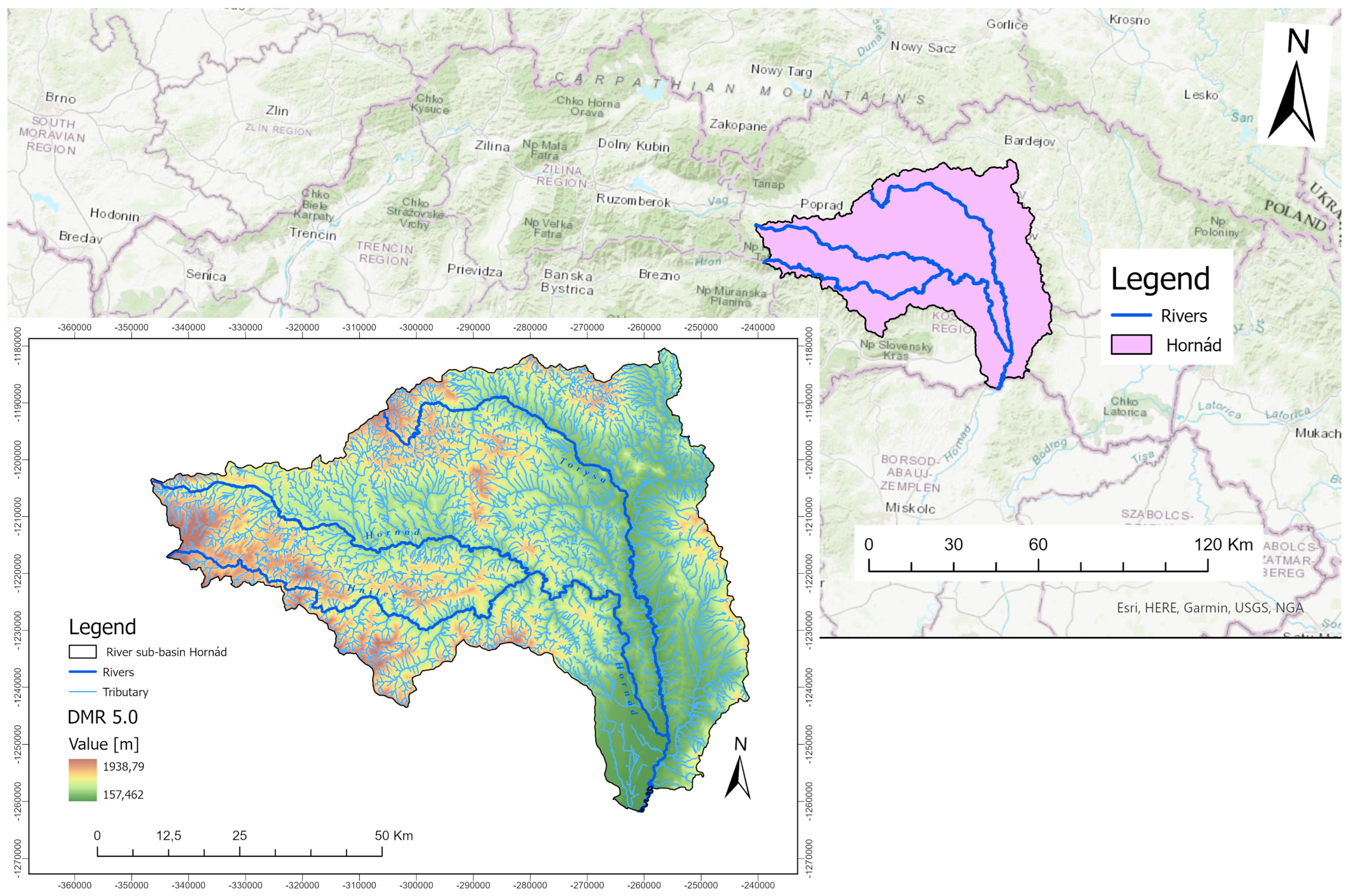

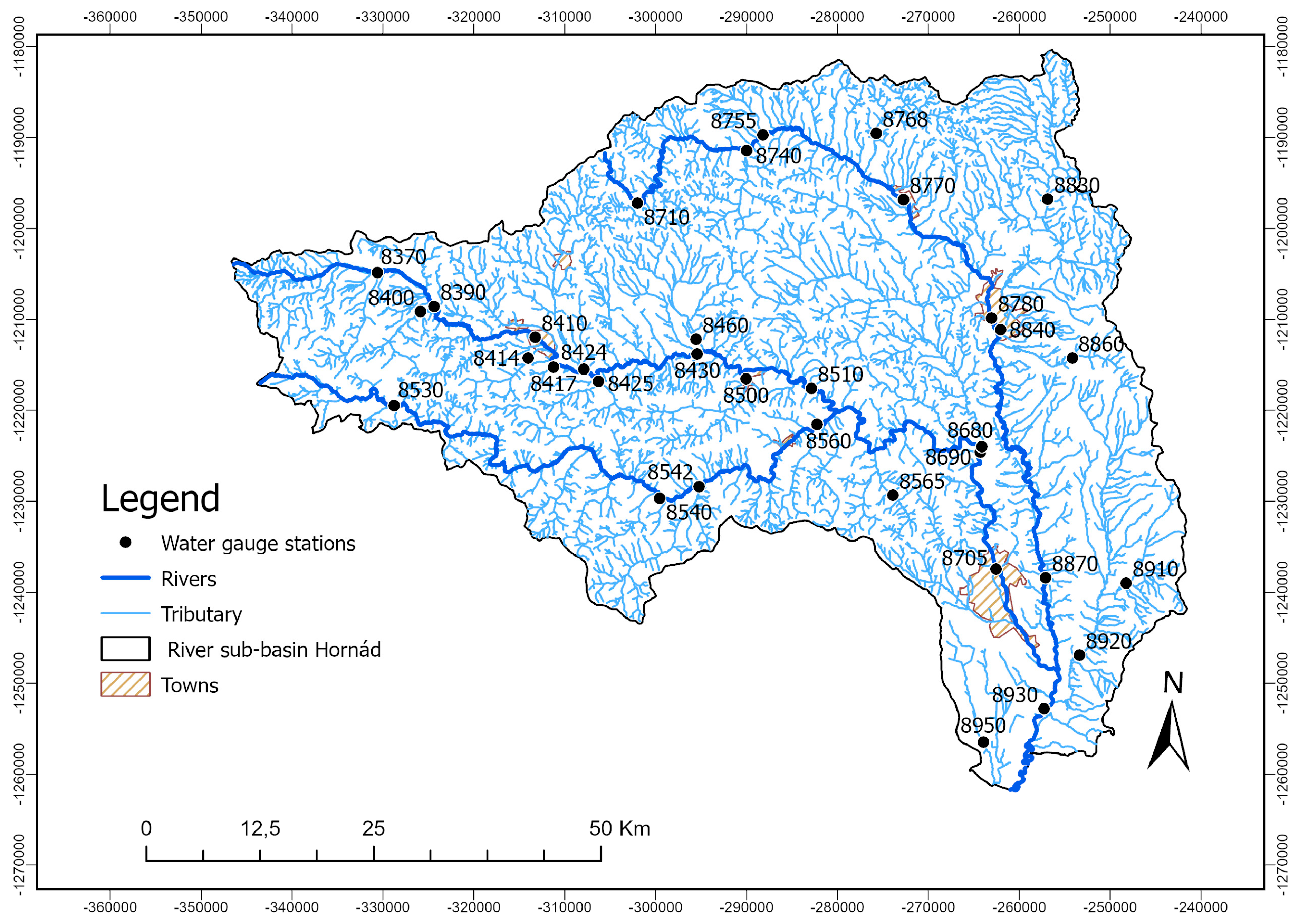

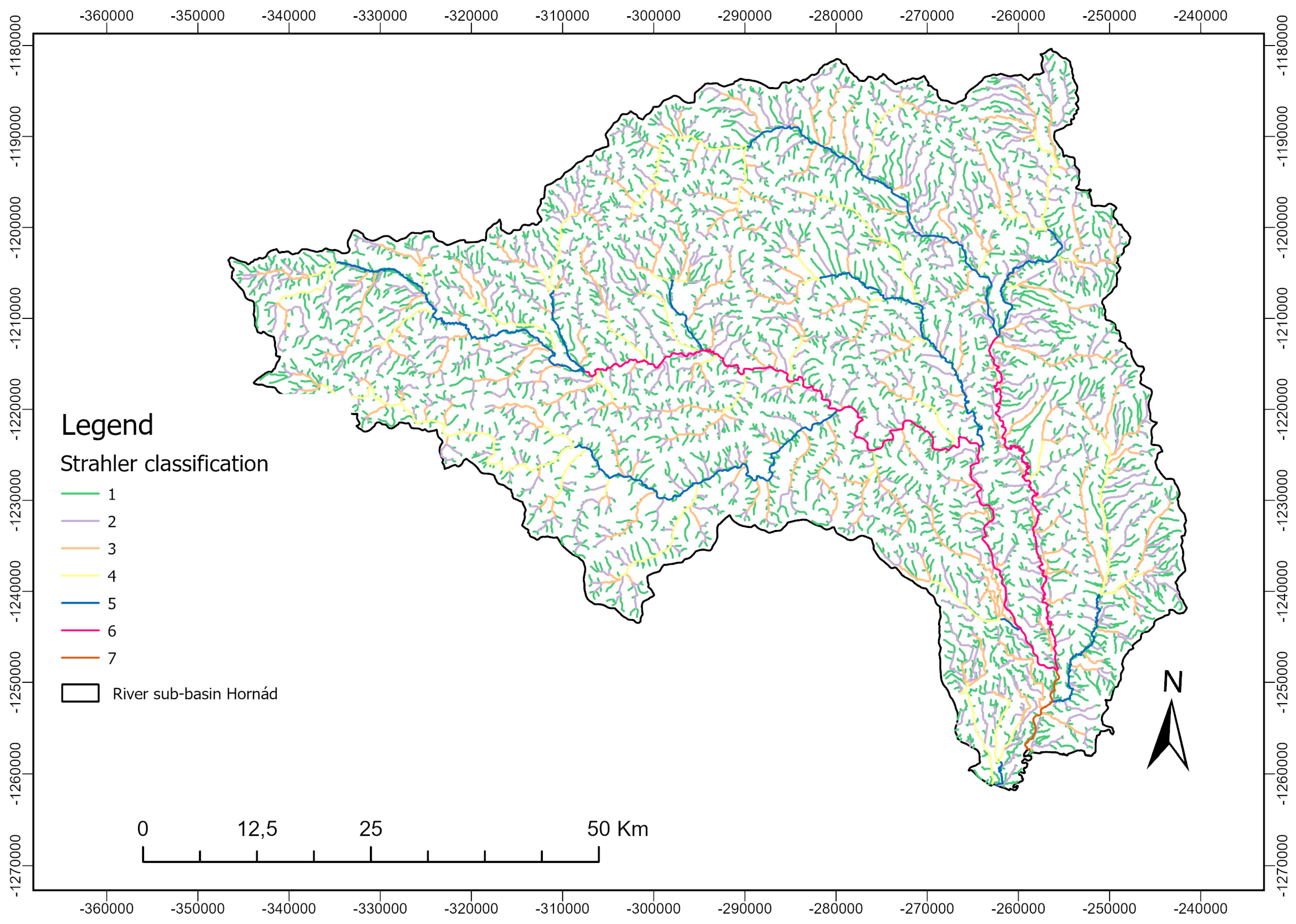

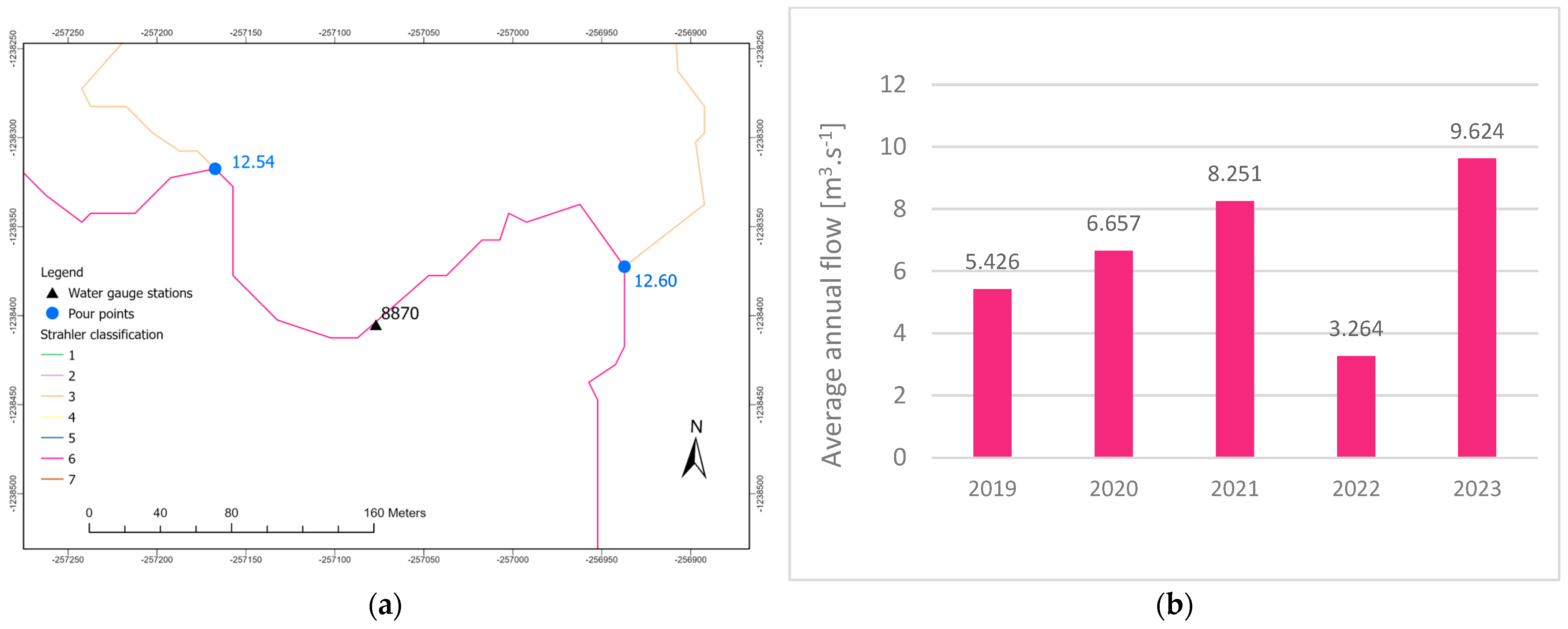
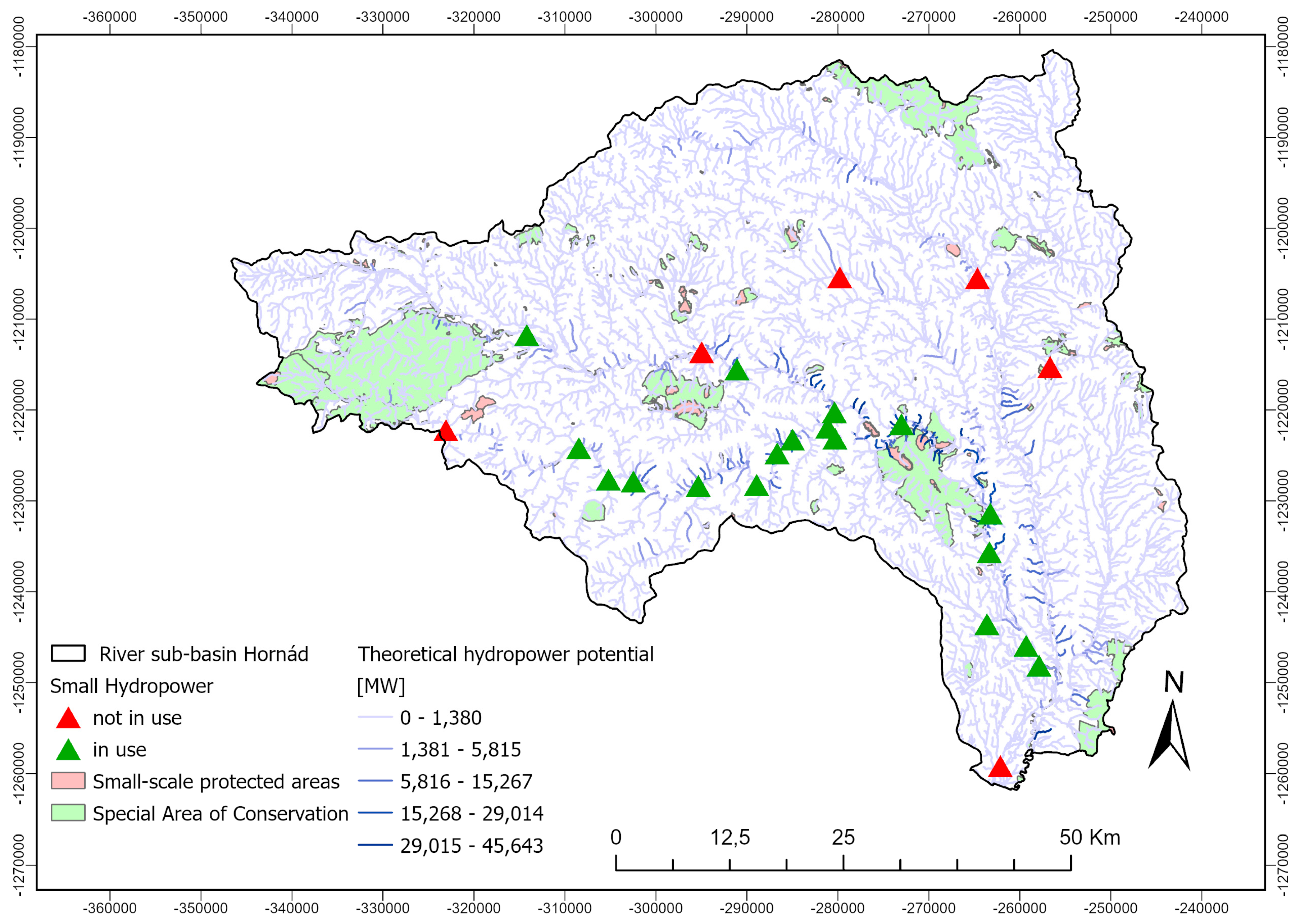


| Level | Name |
|---|---|
| EU | Directive (EU) 2018/2001 [41] |
| EU | Directive 2000/60/EC [42] |
| EU | Directive 2001/42/EC [43] |
| EU | Council Directive 92/43/EEC [44] |
| SR | Energy Policy [45] |
| SR | Energy Security Strategy of the Slovak Republic [5] |
| SR | Act No. 364/2004 Coll. [46] |
| SR | Decree No. 211/2005 Coll. [47] |
| SR | Decree No. 433/2005 Coll. [48] |
| SR | Act No. 309/2009 Coll. [49] |
| SR | Act No. 24/2006 Coll. [50] |
| SR | Act No. 25/2025 Coll. [51] |
Disclaimer/Publisher’s Note: The statements, opinions and data contained in all publications are solely those of the individual author(s) and contributor(s) and not of MDPI and/or the editor(s). MDPI and/or the editor(s) disclaim responsibility for any injury to people or property resulting from any ideas, methods, instructions or products referred to in the content. |
© 2025 by the authors. Licensee MDPI, Basel, Switzerland. This article is an open access article distributed under the terms and conditions of the Creative Commons Attribution (CC BY) license (https://creativecommons.org/licenses/by/4.0/).
Share and Cite
Kuzevicova, Z.; Kuzevic, S.; Bobikova, D. Principles for Locating Small Hydropower Plants in Accordance with Sustainability: A Case Study from Slovakia. Geomatics 2025, 5, 54. https://doi.org/10.3390/geomatics5040054
Kuzevicova Z, Kuzevic S, Bobikova D. Principles for Locating Small Hydropower Plants in Accordance with Sustainability: A Case Study from Slovakia. Geomatics. 2025; 5(4):54. https://doi.org/10.3390/geomatics5040054
Chicago/Turabian StyleKuzevicova, Zofia, Stefan Kuzevic, and Diana Bobikova. 2025. "Principles for Locating Small Hydropower Plants in Accordance with Sustainability: A Case Study from Slovakia" Geomatics 5, no. 4: 54. https://doi.org/10.3390/geomatics5040054
APA StyleKuzevicova, Z., Kuzevic, S., & Bobikova, D. (2025). Principles for Locating Small Hydropower Plants in Accordance with Sustainability: A Case Study from Slovakia. Geomatics, 5(4), 54. https://doi.org/10.3390/geomatics5040054








